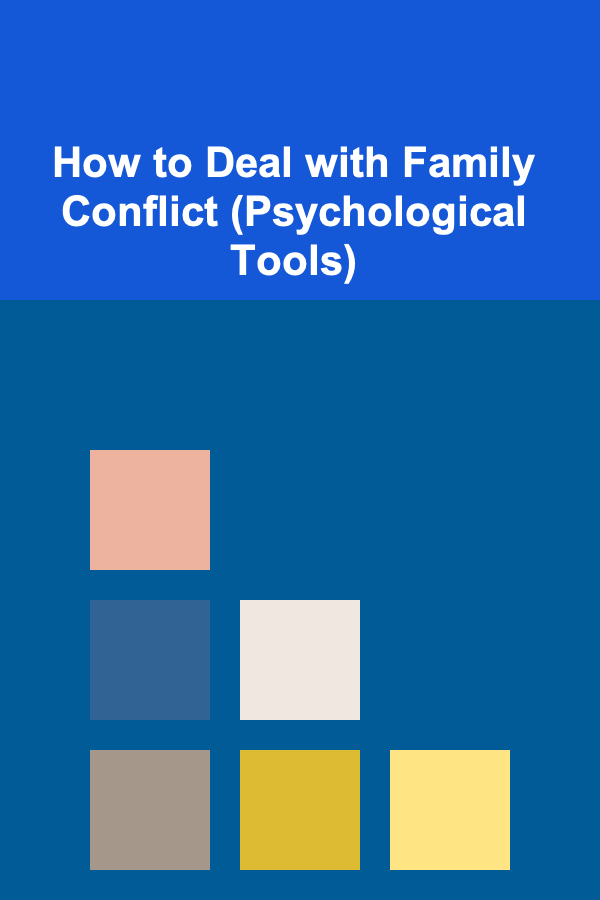
How to Deal with Family Conflict (Psychological Tools)
ebook include PDF & Audio bundle (Micro Guide)
$12.99$5.99
Limited Time Offer! Order within the next:

Family conflicts are an inevitable part of human relationships. Whether it's disagreements between parents and children, marital struggles, sibling rivalry, or generational gaps, conflicts arise due to differing values, needs, and expectations. Understanding how to navigate and resolve these disputes is critical not only for preserving familial relationships but also for fostering individual mental health and emotional well-being.
In this article, we will explore various psychological tools and strategies for dealing with family conflict. These tools are grounded in well-established principles of psychology and emotional intelligence, providing both immediate relief and long-term conflict resolution methods.
Understanding the Root of Family Conflict
Before diving into the tools for conflict resolution, it's essential to understand why family conflict arises in the first place. Often, conflicts stem from differences in values, communication styles, unmet emotional needs, and misunderstandings. Here are some of the main reasons family conflicts may arise:
1. Differences in Values and Beliefs
Family members often have diverse views on politics, religion, lifestyle choices, and personal values. These differences can create friction, especially when individuals feel that their beliefs are being challenged or undermined.
2. Unmet Emotional Needs
Emotions play a significant role in family dynamics. If family members' emotional needs (such as affection, validation, or understanding) are not met, resentment and frustration can build, leading to conflict.
3. Poor Communication
Many family conflicts arise because of poor communication skills. Misunderstandings, failure to listen, and the inability to express emotions in a healthy way contribute to escalating tensions.
4. Power Struggles
In some families, power dynamics come into play, leading to control issues. For example, one family member might feel entitled to make decisions for others, causing resentment and opposition from those who feel powerless.
5. Past Trauma and History
Sometimes, family conflicts are rooted in past experiences or unresolved trauma. Unhealed wounds from childhood or previous events can trigger emotional reactions in present-day situations.
Psychological Tools for Dealing with Family Conflict
While family conflicts can be complex, several psychological tools can help manage and resolve them. These tools focus on enhancing communication, fostering empathy, and developing healthier relationship dynamics.
1. Active Listening
Active listening is one of the most powerful tools in conflict resolution. It involves fully concentrating on what the other person is saying, understanding their point of view, and responding thoughtfully. This method helps reduce misunderstandings and demonstrates respect for the other person's feelings.
Key Elements of Active Listening:
- Giving full attention: Avoid distractions like phones or TV when conversing with family members. Make eye contact and show that you are engaged.
- Reflecting back: Paraphrase or summarize what the other person has said to show you understand their perspective.
- Non-verbal cues: Use body language such as nodding, leaning forward, or maintaining eye contact to indicate you are actively listening.
- Avoiding interruption: Let the other person speak fully before responding. Interrupting can be perceived as dismissive or controlling.
Example: If a teenager is upset about not being trusted to make decisions, instead of immediately defending yourself, you could say, "I hear that you feel frustrated because you want more independence. Let's talk about how we can work together on this."
2. Empathy
Empathy is the ability to understand and share the feelings of another person. It is an essential psychological tool in managing family conflict, as it allows family members to see things from each other's perspectives.
Ways to Practice Empathy:
- Acknowledge the feelings of others: Even if you don't agree with someone's perspective, you can still validate their emotions. This helps reduce defensiveness.
- Put yourself in their shoes: Try to imagine how the other person feels and why they may be reacting the way they are.
- Express understanding: You can say, "I can see how that situation made you feel hurt" or "It sounds like you're feeling overwhelmed."
Empathy promotes trust and helps family members feel understood, which can diffuse tension and create a safer environment for dialogue.
3. Nonviolent Communication (NVC)
Nonviolent Communication (NVC) is a communication framework developed by Marshall Rosenberg that focuses on fostering understanding and compassion while minimizing conflict. NVC involves four key components:
- Observation: State the facts without judgment or interpretation. Example: "I noticed you left the dishes in the sink."
- Feelings: Express your feelings without blaming the other person. Example: "I feel frustrated when the dishes are left out."
- Needs: Express the unmet need behind your feelings. Example: "I need to maintain a clean and organized home."
- Request: Make a specific and positive request. Example: "Would you be willing to wash your dishes after using them?"
NVC reduces defensiveness and creates an opportunity for mutual understanding, as it focuses on needs rather than blame.
4. Reframing
Reframing involves changing the way you interpret or perceive a situation. This psychological tool helps shift negative, conflict-driven thinking into a more constructive and neutral perspective.
Examples of Reframing:
- Instead of thinking, "My sibling always criticizes me," try reframing it to, "My sibling is expressing their opinion, and perhaps they are concerned about me."
- If a parent is frustrated with a child's behavior, instead of thinking, "My child is being rebellious," reframe it as, "My child is testing boundaries, which is a normal part of development."
Reframing helps reduce emotional escalation and opens the door for problem-solving and empathy.
5. Setting Boundaries
Establishing healthy boundaries is crucial for maintaining peace in family relationships. Boundaries are limits you set to protect your mental and emotional well-being. In family conflict, it's important to communicate your boundaries clearly and assertively.
Tips for Setting Boundaries:
- Be clear and direct: Don't leave room for interpretation. For example, "I need some quiet time to decompress after work. I'd like to talk later."
- Be respectful but firm: Boundaries should be communicated with respect for the other person's needs but must also be non-negotiable for your well-being.
- Stick to your boundaries: Don't back down just to avoid conflict. Consistency is key in enforcing healthy boundaries.
Setting boundaries ensures that you can maintain your sense of self and prevent being overwhelmed by the dynamics of family conflict.
6. Mindfulness
Mindfulness refers to staying present and aware of your thoughts, emotions, and physical sensations in the moment. It is a powerful tool for managing emotional reactivity and preventing escalation in family conflicts.
How Mindfulness Helps:
- Emotional regulation: By being aware of your emotions as they arise, you can choose how to respond instead of reacting impulsively.
- Increased patience: Mindfulness cultivates patience by helping you detach from immediate emotional reactions.
- Decreased stress: When you practice mindfulness, you can reduce the physical and mental stress associated with conflict.
A simple mindfulness exercise is to take deep breaths, count to four as you inhale and exhale, and focus on your breath. This can help you stay calm during an emotionally charged conversation.
7. Cognitive Behavioral Therapy (CBT) Techniques
Cognitive Behavioral Therapy (CBT) focuses on identifying and changing negative thought patterns that contribute to emotional distress and conflict. Family members can use CBT techniques to challenge distorted thoughts that may fuel conflicts.
CBT Techniques for Family Conflict:
- Identify negative thoughts: Recognize thoughts like, "My mother never listens to me" or "My partner always ignores my needs."
- Challenge those thoughts: Ask yourself, "Is this thought based on facts or assumptions? What evidence do I have for this belief?"
- Reframe negative thoughts: Replace unhelpful thoughts with more balanced ones, such as, "I may not always agree with my mother, but we can still communicate effectively if we listen to each other."
Using CBT helps family members reframe negative thinking and cultivate healthier, more productive perspectives.
8. Forgiveness
Forgiveness is a powerful tool for healing and letting go of grudges. Holding on to resentment can prolong conflicts and damage family relationships. Forgiveness is not about excusing someone's behavior but about releasing the emotional burden and moving forward.
How to Practice Forgiveness:
- Acknowledge the hurt: Don't suppress your emotions. Acknowledge how the conflict or the person's actions have affected you.
- Choose to forgive: Understand that forgiveness is a personal choice. It's about freeing yourself from the emotional toll of resentment.
- Let go of expectations: Forgiveness doesn't mean that the other person will change. It's about letting go of the need for them to make amends in order for you to heal.
Forgiveness brings emotional freedom, allowing family members to rebuild trust and harmony.
Conclusion
Family conflict is a natural part of relationships, but it doesn't have to be destructive. By using psychological tools like active listening, empathy, nonviolent communication, reframing, and setting boundaries, families can manage and resolve conflicts in healthier ways. Furthermore, techniques such as mindfulness, forgiveness, and cognitive-behavioral approaches can improve emotional regulation and communication, leading to stronger and more harmonious relationships.
The key to dealing with family conflict is not avoiding it but developing the emotional intelligence and communication skills needed to handle it constructively. By adopting these psychological tools, families can navigate their differences with greater understanding, compassion, and respect.

How to Choose a Crypto Wallet
Read More
How to Earn Passive Income by Teaching Deep Learning Online
Read More
How to Make Money Online as a Relationship Coach: 10 Actionable Ideas
Read More
How to Pair Craft Beer with Seafood
Read More
How To Observe Solar Eclipses Safely
Read More
Top 5 Feng Shui Mistakes People Make (and How to Fix Them)
Read MoreOther Products

How to Choose a Crypto Wallet
Read More
How to Earn Passive Income by Teaching Deep Learning Online
Read More
How to Make Money Online as a Relationship Coach: 10 Actionable Ideas
Read More
How to Pair Craft Beer with Seafood
Read More
How To Observe Solar Eclipses Safely
Read More